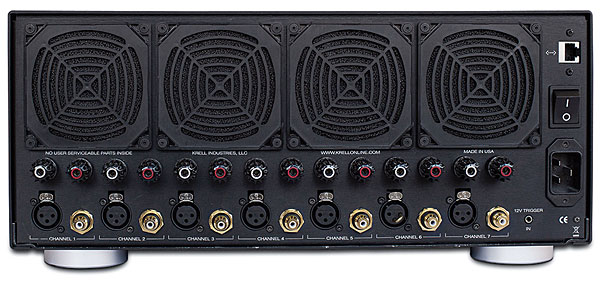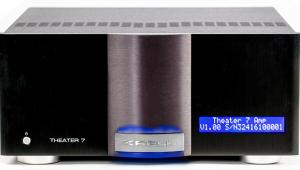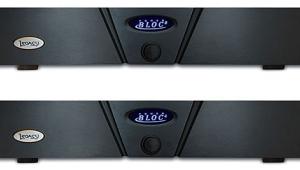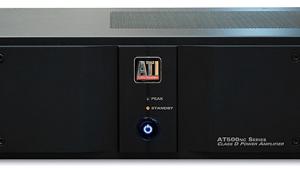Krell Chorus 7200 Amplifier Page 2
The Fun Begins
Once I installed the seven-channel Chorus 7200, I hooked it up to my Marantz AV8801 surround processor and calibrated the sound levels to my speakers: three M&K S150s across the front, four M&K SS150 surround speakers, and two subwoofers—a brand-new HSU VTF-15H MK2 situated at about the midpoint of my right wall and an SVS PC-Ultra sitting in the front left corner of the room.
I lived with the Krell for a few days before really putting it to the test, but I was impressed by its neutral tonal quality out of the gate. Not too bright, not too laid-back. When I finally sat down for some critical listening, I truly started to appreciate how sweet this amp sounded.
I began with an eclectic collection of SACDs, including the Telarc SACD Sampler 1 recording of “Moanin’ ” by Monty Alexander from his Monty Meets Sly and Robbie album. This jazz-meets-Jamaica recording features Alexander gracefully moving his fingers across the keys of a Yamaha grand piano while a smooth rhythm section plays in the background, with Sly Dunbar on drums (and riddim) and Robbie Shakespeare on bass. The song is a lot of fun, with Monty’s piano slightly left of center, Sly’s drums to the right, and Robbie’s tight bass filling the room. Every strike of the piano is clean, and the midrange is full of body. As I pushed the volume higher and higher, the instrumental track never strained the amplifier, and it was able to resolve all of the detail in the music without any obvious coloration.
I could say the same for a number of Red Book CDs ripped to FLAC files on my home server. The Spin Doctors’ “Two Princes” is lyrically challenged for sure, but I’ve always enjoyed the rhythm of the track, especially the percussion beat that opens the song and the guitar solo midway through that instantly transports me back to my early 20s. Wow was the first thought in my mind as the drums kicked to life. Was the band playing live in my room? My reference Parasound Halo A 51 amp is a Class A/B that operates in Class A mode up to a few watts, but I can’t say that I remember this recording sounding quite this crisp and clean, with the voices projecting well into the room and the guitars layered in the background.

Class A amp makers tout their products’ ability to re-create voice, and here the Krell truly shined. Take the start of fun.’s “Some Nights,” where Nate Ruess’ voice kicks off the song with a catchy ballad-like opening that transports you back in rock history to harmonies from groups such as Queen and Styx (those bands also shine on the 7200). With this amp in the chain, Ruess’ melody came alive with seemingly limitless dynamics, a 3D-like soundstage, and amazing detail.
This dynamic performance was readily apparent with every Blu-ray I threw at the Krell. The beach landing in Saving Private Ryan exploded into my room, with each discrete effect placed precisely in the soundstage. And the 7200 brought an uncanny immediacy to softer passages, such as the opening monologue recited by Morgan Freeman in Clint Eastwood’s Million Dollar Baby, where it truly sounded as if Freeman was sitting in the room with me describing Frankie Dunn’s personality and why he wouldn’t train girls to fight. Impressive is an understatement.
A Strong Foundation
I spent the vast majority of my review time using my reference Marantz surround processor, but Krell really wanted me to pair this fantastic amplifier with their entry-level Foundation surround processor ($6,500, an S&V Top Pick of the Year, reviewed April 2014). Michael Fremer raved about the Foundation’s prowess in his review, and I have to concur 100 percent. As good as the Chorus 7200 sounded with my Marantz, the Foundation took it up a notch, and I now have some serious processor envy and a strong case of upgrade-itis due to this combo’s audio muscle. The Foundation isn’t the most ergonomically friendly processor I’ve ever used—setting it up was about as much fun as a root canal—but it’s by far the best-sounding. The soundstage is incredibly convincing: You can’t really tell where the speakers are in the room, and the subwoofer integration is by far the best I’ve ever experienced. Like Michael, when I put my Marantz back in my rack, I felt like I needed a prescription for Prozac to fight the depression I was facing.
Putting It Into Words
The hardest part of reviewing audio equipment is putting what you hear into words that can impart upon the reader just how impressive (or uninspired) a particular piece of equipment was to your ears. In the case of the Chorus 7200—and Foundation—it was six weeks of audio bliss for me and my family. My son actually sat on the couch with me to listen to music because it had never sounded so alive, but when I broke the news that the processor/amp combo cost $16,000, he knew instantly our days of audio bliss were numbered.
The only complaint I have about both the amp and processor is the non-dimming backlight that hides behind the Krell logo on each unit. When I was listening to music, they didn’t bother me one bit, but when the room lights were off and I was trying to watch a movie, the blue LEDs were so bright that I thought they might be able to lead a wayward ship into port after a long journey at sea.
At $9,500, the Chorus 7200 isn’t cheap by any means, but its iBias technology delivers bliss for a relatively low cost per channel when compared against the cost of traditional high-end Class A amps. If you’re in the market for a new amp and are a member of the cost-is-little-object crowd, definitely check out the Chorus 7200 from Krell. You won’t be disappointed.





























































